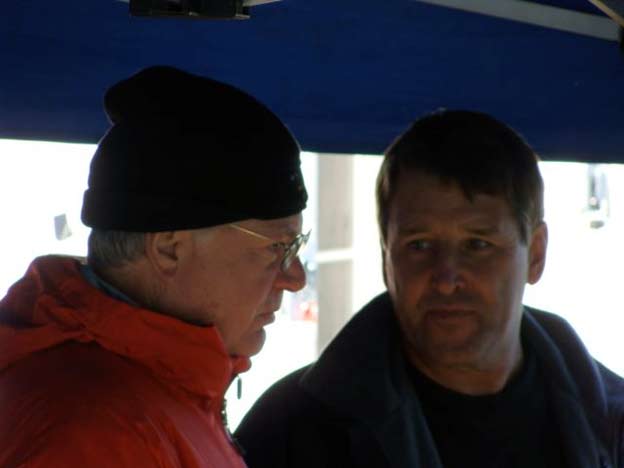
Jim Kearney (L) confers with D Sports Racer driver Jim Hallman at the 2012 SCCA National Runoffs, Road America, Wisconsin.
Q. How can you help a driver go faster just by talking to them?
A. Drivers are overwhelmed by input. I put in place a method of review to sort it out. A good debrief routine makes it easier to remember how the car and driver performed in the prior session. We pick three things to work on in in the next session. A calm and thoughtful discussion goes a long way toward helping a driver feel prepared for the next challenge. Drivers go better when they are confident.
Q. How much information can you get by observing in one turn?
A. I go to the critical turns and I compare my driver with the best. I take segment times and I watch the lines. Some issues are obvious when viewed from outside the car. Most importantly, I listen very carefully to how the driver describes the track sections where they are uncomfortable. I’ll observe those segments and review in-car footage. Small adjustments can have significant benefits.
Q. Why does an experienced driver need a coach? If they don’t know how to drive by now, how can you teach them?
A. Two heads are better than one. Racing is a complex activity. It is easy to get lost in a myriad of considerations. I work with drivers to have a plan for every session and to work on a maximum of two to three things each time out. All top athletes have a coach. I’m not an instructor; I don’t teach anyone how to drive. Asking the right questions helps a driver find their own answers. Every driver is different but they all want to improve in a safe manner.
Q. How did you learn to be a coach?
A. I raced for thirty-two years. I paid a lot of attention to the coaches I used when I raced. I thought a lot about the mental game and how best to present myself to the track. As a lawyer, I learned to listen closely to people and get on their wave length quickly so I could help them. Coaching is not so different.
Q. If you are not a mechanic, how can you adjust the car?
A. I tune the helmet, not the car. I am not an engineer. While I fielded my own car and learned a lot about Formula Vee, I don’t pretend to be a prep shop guru. I help racers analyze their driving and race craft. A positive mental approach is like horsepower. The more you have, the better you go.
Q. How can you work with more than one driver? Particularly if they are in the same race, doesn’t that present a conflict?
A. I sometimes work with multiple drivers in an effort to keep my fees down. I always disclose who I am working with and I share no information between drivers unless they specifically request me to do so. My goal is to help each driver run their very best race. I am very organized and well prepared.
